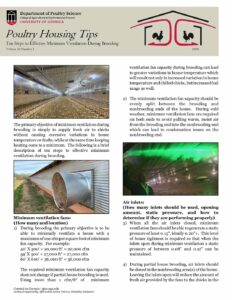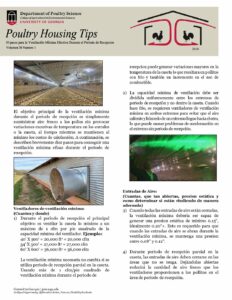The primary objective of minimum ventilation during brooding is simply to supply fresh air to chicks without causing excessive variations in house temperature or drafts, while at the same time keeping heating costs to a minimum. The following is a brief description of ten steps to effective minimum ventilation during brooding.
Minimum ventilation fans:
(How many and location)
1) During brooding the primary objective is to be able to minimally ventilate a house with a maximum of one c...fm per square foot of minimum fan capacity. For example:
40' X 500' = 20,000 ft2 = 20,000 cfm
54' X 500' = 27,000 ft2 = 27,000 cfm
60' X 600' = 36,000 ft2 = 36,000 cfm
The required minimum ventilation fan capacity does not change if partial house brooding is used. Using more than 1 cfm/ft2 of minimum ventilation fan capacity during brooding can lead to greater variations in house temperature which will result not only in increased variation in house temperature and chilled chicks, but increased fuel usage as well.
2) The minimum ventilation fan capacity should be evenly split between the brooding and nonbrooding ends of the house. During cold weather, minimum ventilation fans are required on both ends to avoid pulling warm, moist air from the brooding end into the nonbrooding end which can lead to condensation issues on the nonbrooding end.
Air inlets:
(How many inlets should be used, opening amount, static pressure, and how to determine if they are performing properly)
3) When all the air inlets closed, minimum ventilation fans should be able to generate a static pressure of least 0.15", ideally 0.20"+. This level of house tightness is required so that when the inlets open during minimum ventilation a static pressure of between 0.08" and 0.12" can be maintained.
4) During partial house brooding, air inlets should be closed in the nonbrooding area(s) of the house. Leaving the inlets open will reduce the amount of fresh air provided by the fans to the chicks in the brooding area.
5) Generally, one half of the inlets in the brooding area should be generally latched closed. This will make it easier to obtain the optimal combination of inlet opening and static pressure when the minimum ventilation fans operate.
6) Depending on factors such as house width, inlet type, inlet positioning, inside/outside temperature difference, etc. an inlet opening of 2" (+/-1") at a static pressure of 0.10" (+/- 0.02") is generally required to throw cold incoming air near the center of a house.
7) 12" pieces of surveying tape should be hung from the ceiling every three to five feet directly in front of an inlet on each side of the house. The goal is to get the surveying tape approximate five feet from the peak of the ceiling to lightly flicker when the minimum ventilation fans are operating.
Fresh air requirements:
(Starting point and how to adjust)
8) At placement, minimum ventilation fan timers should be set to bring in a minimum of 0.1 cfm per chick. For example:
20,000 chicks = 2,000 cfm.
Two 10,000 cfm minimum ventilation fans (20,000 cfm) = 2,000 cfm/20,000 cfm = 0.10
Five-minute-interval timer (300 seconds) =300 seconds X 0.10 = 30 seconds on/270 off
35,000 chicks = 3,500 cfm.
Three 10,000 cfm minimum ventilation fans (30,000 cfm) = 3,500 cfm/30,000 cfm = 0.12
Five-minute-interval timer (300 seconds) =300 seconds X 0.12 = 36 seconds on/270 off
9) The ideal relative humidity is between 40 and 60%. Relative humidity should be checked each morning. If the relative humidity is approaching 55%, minimum ventilation rates should be increased by approximately 50%. Minimum ventilation rates should also be increased if ammonia is over 25 ppm.
Supplemental house air mixing:
(Improving environmental uniformity)
10) Circulation fans located along the centerline of a house should operate continuously during brooding. If a house is equipped with two rows of circulation fans they will likely need to be turned off when the minium ventilation fans are operating.
Details
| Year | Volume | Number | Categories |
|---|---|---|---|
| 2024 | 36 | 1 |


